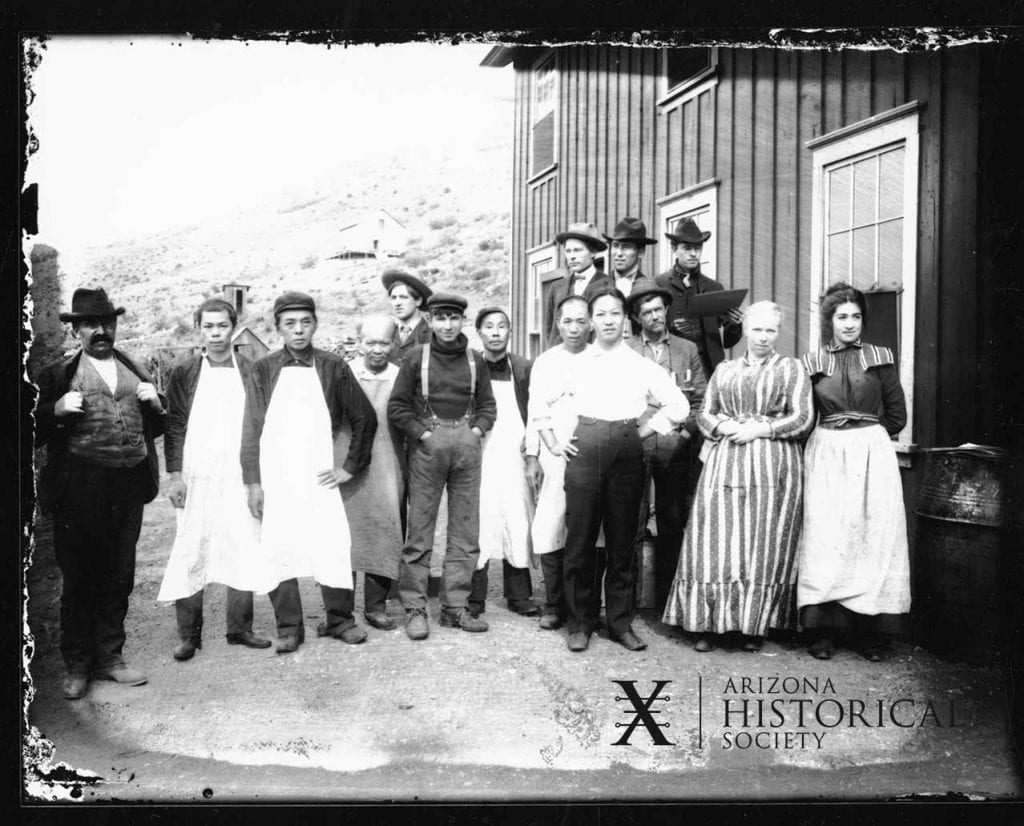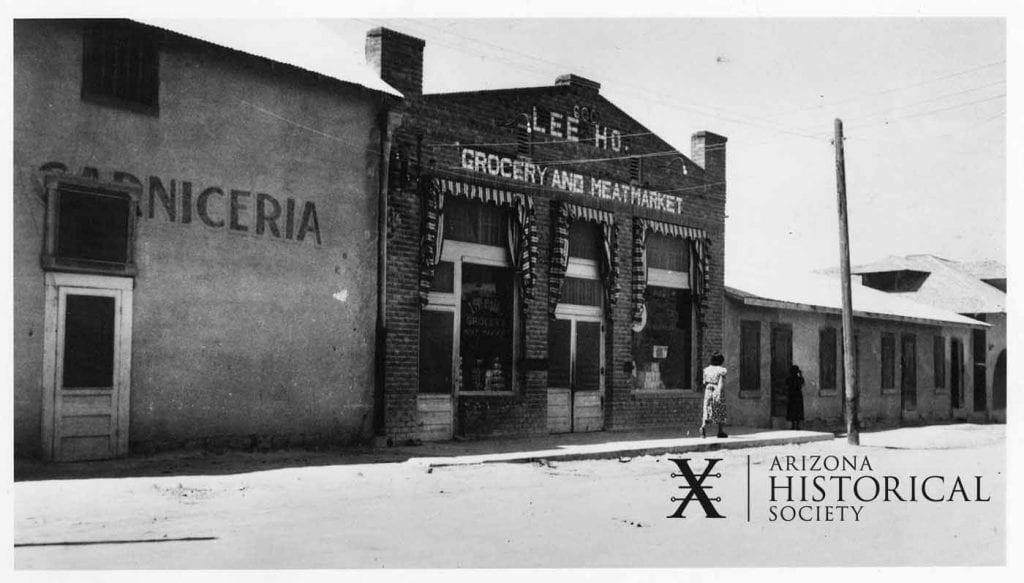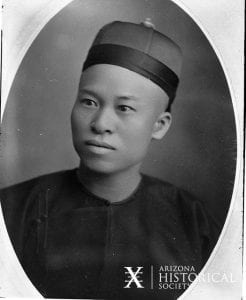When you think about Chinese people in Arizona or the West, what comes to mind? Perhaps it’s the iconic Dragon Gate marking the entrance to San Francisco’s Chinatown. Maybe you recall something from an Arizona history class in high school about how the Chinese helped build the railroads. Or maybe it’s a glimpse of Chinese workers in the background in an old western movie you watched on a lazy Sunday afternoon.

Kitchen Staff at Clifton Hotel, undated, #100-0001622
If you’d describe your knowledge of this aspect of Arizona history as cursory at best, you are not alone. Details about the history and contributions of Chinese immigrants and their descendants to Arizona have been frequently overlooked. Despite the fact that people of Chinese descent have been in Arizona since the 1800s, this history is often presented as not much more than a footnote. Even in the 60 years that the Arizona Historical Society has been publishing the Journal of Arizona History, only 17 articles have been published focusing on Chinese history in Arizona.
That said, while the volume of articles is small, they are rich in details, and worth a read if you would like to fill in a gap in your historical knowledge. Here are a handful of articles from the Journal of Arizona History that I’ve found particularly helpful in expanding my knowledge on this topic.

Lee Ho Grocery and Meat Market at 600 S. Meyer Avenue in Tucson, ca. 1940, #100-0000102
In his article “Sojourners and Settlers: The Chinese Experience in Arizona” (https://www.jstor.org/stable/42678261), from the Autumn 1980 edition, author Lawrence Michael Fong provides a broad overview of Chinese immigration to Arizona, and details how these immigrants carved out a place for themselves in the economy and society of the booming Arizona Territory, and later nascent state. Fong provides an excellent starting point for those wishing to deepen their knowledge of Chinese people across the entire state of Arizona. It is also worth noting, that all four of the articles in this edition of the Journal focus on immigrants and their contributions to Arizona and the region, with three of them focusing specifically on Chinese immigrants.
 Fong notes in his article, “The great problem for every Chinese community was to be apart from, yet part of, the larger society.” Examples of this can be seen in Author Gary P. Tipton’s Autumn 1977 article, “Men Out of China: Origins of the Chinese Colony in Phoenix” (https://www.jstor.org/stable/42678073), which highlights the difficulties of researching a group of people who were alternately persecuted, or ignored by the dominant society. Despite this, Tipton is still able to piece together the hidden history of Phoenix’s Chinese community largely through a mix of census records and oral histories. In doing so, he paints a portrait of a small, but thriving community with as long a history in the city as their European-American neighbors.
Fong notes in his article, “The great problem for every Chinese community was to be apart from, yet part of, the larger society.” Examples of this can be seen in Author Gary P. Tipton’s Autumn 1977 article, “Men Out of China: Origins of the Chinese Colony in Phoenix” (https://www.jstor.org/stable/42678073), which highlights the difficulties of researching a group of people who were alternately persecuted, or ignored by the dominant society. Despite this, Tipton is still able to piece together the hidden history of Phoenix’s Chinese community largely through a mix of census records and oral histories. In doing so, he paints a portrait of a small, but thriving community with as long a history in the city as their European-American neighbors.
In their article “Beyond Border Spectacle: Oral History and Everyday Meaning in Chinese Mexican Tucson” (https://muse.jhu.edu/article/775434), from the Autumn/Winter 2020 edition, authors Priscilla M. Martínez and Grace Peña Delgado again turn to oral history to detail the long and deep ties between the Chinese and Mexican communities in Tucson. Throughout the long periods of discriminatory laws that restricted the rights of Chinese immigrants to own land, or work specific jobs, many in Tucson were able to find refuge, and circumvent restrictions by forging close ties, often through marriage, with Tucson’s Mexican-American community. Through interviews with living Tucsonans of Chinese and Mexican descent, the authors provide a compelling look at a community that is still very present in Tucson.
Taking a somewhat different approach, author Suey Wong utilizes immigration records found at the National Archives to show the impact of the anti-Chinese legislation of the 1800s and early 1900s, one Arizona citizen. By keeping the focus of the research for the Summer 2018 article “Implementing the 1917 Immigration Act: How One Chinese Immigrant Slipped Through the Cracks of the U.S. Immigration Bureaucracy” (https://muse.jhu.edu/article/737910), on a single individual (the author’s great grandfather), Wong brings a very human story to the impact of some rather inhumane legislation.
In reading about the history of Chinese immigrants to the U.S., particularly in the 1800 and early 1900s, one will notice a heavy focus on men. This is largely because the 1875 Page Act barred Chinese women from entering the United States, depicting most of them as arriving in the U.S. solely to work as prostitutes. Despite this ban, some Chinese women did make their way to the U.S. Some with their husbands, and others trafficked by secretive means to meet the needs of single Chinese men already in the US. In her article “In Search of a Homeland: Lai Ngan, a Pioneer Chinese Woman and Her Family on the U.S.-Mexico Border” (https://www.jstor.org/stable/41697389), author Li Yang tells the story of Lai Ngan, who arrived in the U.S. as a baby with performers in a Cantonese Opera troupe touring San Francisco. Lai Ngan worked as a servant girl, and eventually married, and moved with her husband and children to Nogales, Arizona. The article details her life living on both sides of the U.S.-Mexico border.
These are just a few articles that help shine a light on the rich, but less well-known history of people of Chinese descent in Arizona. Hopefully they will inspire you to learn more about this history in Arizona and the United States.
More study and research are needed to continue to uncover these stories from the past. For those interested in doing more research, the Arizona Historical Society’s Library and Archives is a good place to start. Click here to find out more about accessing our collections.
Please note: Links to the articles featured here are available online through JSTOR or Project MUSE. Currently, articles available through JSTOR are free to read with the creation of an account, Project MUSE does charge a fee for access. However, current members of the Arizona Historical Society can access all content free of charge, and also receive each new edition of the Journal. Click here to learn more or become a member.
Rachael Black
Archivist & Librarian
Email Library & Archives




